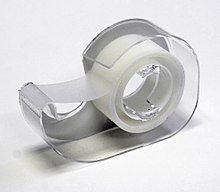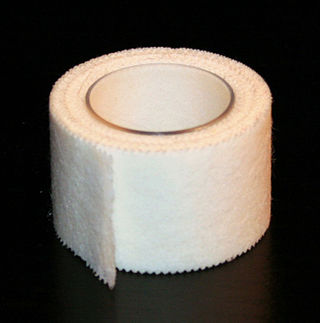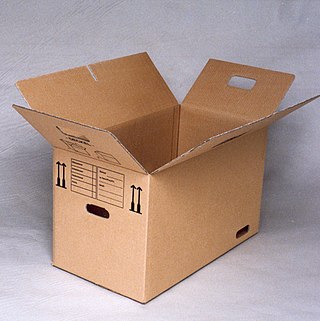This article needs additional citations for verification .(October 2008) |

Adhesive tape is one of many varieties of backing materials coated with an adhesive. Several types of adhesives can be used. [1]
This article needs additional citations for verification .(October 2008) |

Adhesive tape is one of many varieties of backing materials coated with an adhesive. Several types of adhesives can be used. [1]

Pressure-sensitive tape, PSA tape, self-stick tape or sticky tape consists of a pressure sensitive adhesive coated onto a backing material such as paper, plastic film, cloth, or metal foil. It is sticky (tacky) without any heat or solvent for activation and adheres to surfaces with light pressure. Typical adhesives are polymers such as acrylates, natural, and synthetic rubber. These tapes usually require a release agent on their backing or a release liner to cover the adhesive. Sometimes, the term "adhesive tape" is used for these tapes.
Water-activated tape, gummed paper tape or gummed tape is starch- or sometimes animal glue-based adhesive on a paper backing which becomes sticky when moistened.
A specific type of gummed tape is called reinforced gummed tape (RGT). The backing of this reinforced tape consists of two layers of paper with a cross-pattern of fiberglass filaments laminated between. The laminating adhesive had previously been asphalt but now is more commonly a hot-melt atactic polypropylene.
Gummed tapes are described in ASTM D5749-01(2006) [2] Standard Specification for Reinforced and Plain gummed Tape for Sealing and Securing.
Water-activated tape is used for closing and sealing boxes. Before closing corrugated fiberboard boxes, the tape is wetted or remoistened, activated by water. The tape is mostly 3 inch or 7,5 cm wide.
Heat-activated tape is usually tack-free until it is activated by a heat source. It is sometimes used in packaging, for example, a tear strip tape for cigarette packs. Conversely, thermal release tape, such as REVALPHA by Nitto Denko, loses its tack and fully releases when heated to a certain temperature. This is particularly useful in the semiconductor industry.
Drywall tape is paper, cloth, or mesh, sometimes with a gummed or PSA adhesive. It is used to make the joints between sheets of drywall materials. [3]

Adhesive, also known as glue, cement, mucilage, or paste, is any non-metallic substance applied to one or both surfaces of two separate items that binds them together and resists their separation.

Duct tape is cloth- or scrim-backed pressure-sensitive tape, often coated with polyethylene. There are a variety of constructions using different backings and adhesives, and the term 'duct tape' has been genericized to refer to different cloth tapes with differing purposes. A variation is heat-resistant foil tape useful for sealing heating and cooling ducts, produced because the adhesive on standard duct tape fails and the synthetic fabric reinforcement mesh deteriorates when used on heating ducts.

Corrugated fiberboard or corrugated cardboard is a type of packaging material consisting of a fluted corrugated sheet and one or two flat linerboards. It is made on "flute lamination machines" or "corrugators" and is used for making corrugated boxes. The corrugated medium sheet and the linerboard(s) are made of kraft containerboard, a paperboard material usually over 0.25 millimetres (0.01 in) thick.

Sandpaper and glasspaper are names used for a type of coated abrasive that consists of sheets of paper or cloth with abrasive material glued to one face.

Lamination is the technique/process of manufacturing a material in multiple layers, so that the composite material achieves improved strength, stability, sound insulation, appearance, or other properties from the use of the differing materials, such as plastic. A laminate is a permanently assembled object created using heat, pressure, welding, or adhesives. Various coating machines, machine presses and calendering equipment are used.

Masking tape, also known as painter's tape, is a type of pressure-sensitive tape made of a thin and easy-to-tear paper, and an easily released pressure-sensitive adhesive. It is available in a variety of widths. It is used mainly in painting, to mask off areas that should not be painted.

A label is a piece of paper, plastic film, cloth, metal, or other material affixed to a container or product, on which is written or printed information or symbols about the product or item. Information printed directly on a container or article can also be considered labelling.

A heat sealer is a machine used to seal products, packaging, and other thermoplastic materials using heat. This can be with uniform thermoplastic monolayers or with materials having several layers, at least one being thermoplastic. Heat sealing can join two similar materials together or can join dissimilar materials, one of which has a thermoplastic layer.

A tape dispenser is an object that holds a roll of tape and has a mechanism at one end to shear the tape. Dispensers vary widely based on the tape they dispense. Abundant and most common, clear tape dispensers are commonly made of plastic, and may be disposable. Other dispensers are stationary and may have sophisticated features to control tape usage and improve ergonomics.

Surgical tape or medical tape is a type of pressure-sensitive adhesive tape used in medicine and first aid to hold a bandage or other dressing onto a wound. These tapes usually have a hypoallergenic adhesive which is designed to hold firmly onto skin, dressing materials, and underlying layers of tape, but to remove easily without damaging the skin. They allow air to reach the skin ("breathable"). Some breathable tapes such as kinesiology tape, and other elastic bandages with adhesive are made of cotton. Surgical tape is often white because it contains zinc oxide, which is added to help prevent infections. Tapes made of porous material, such as 3M Micropore, are widely used.

Pressure-sensitive adhesive is a type of nonreactive adhesive which forms a bond when pressure is applied to bond the adhesive with a surface. No solvent, water, or heat is needed to activate the adhesive. It is used in pressure-sensitive tapes, labels, glue dots, stickers, sticky note pads, automobile trim, and a wide variety of other products.

Speed tape is an aluminium pressure-sensitive tape used to perform minor repairs on aircraft and racing cars. It is used as a temporary repair material until a more permanent repair can be carried out. It has an appearance similar to duct tape, for which it is sometimes mistaken, but its adhesive is capable of sticking on an airplane fuselage or wing at high speeds, hence the name.
Tape or Tapes may refer to:
Deinking is the industrial process of removing printing ink from paperfibers of recycled paper to make deinked pulp.

Box-sealing tape, parcel tape or packing tape is a pressure-sensitive tape used for closing or sealing corrugated fiberboard boxes. It consists of a pressure-sensitive adhesive coated onto a backing material which is usually a polypropylene or polyester film which is oriented to have strength in both the long (machine) direction and the cross direction.

Filament tape or strapping tape is a pressure-sensitive tape consisting of a pressure-sensitive adhesive coated onto a backing material which is usually a polypropylene or polyester film and fiberglass filaments embedded to add high tensile strength.

Corrugated box design is the process of matching design factors for corrugated fiberboard boxes with the functional physical, processing and end-use requirements. Packaging engineers work to meet the performance requirements of a box while controlling total costs throughout the system. Corrugated boxes are shipping containers used for transport packaging and have important functional and economic considerations.

Pressure-sensitive tape, known also in various countries as PSA tape, adhesive tape, self-stick tape, sticky tape, Sellotape, or just tape, is an adhesive tape that will stick with application of pressure, without the need for a solvent or heat for activation.
The chemistry of pressure-sensitive adhesives describes the chemical science associated with pressure-sensitive adhesives (PSA). PSA tapes and labels have become an important part of everyday life. These rely on adhesive material affixed to a backing such as paper or plastic film.

Package handles, or carriers, are used to help people use packaging. They are designed to simplify and to improve the ergonomics of lifting and carrying packages. Handles on consumer packages add convenience and help facilitate use and pouring. The effect of handles on package material costs and the packaging line efficiencies are also critical. A handle can be defined as “an accessory attached to a container or part for the purpose of holding or carrying.” Sometimes a handle can be used to hang a package for dispensing or use.